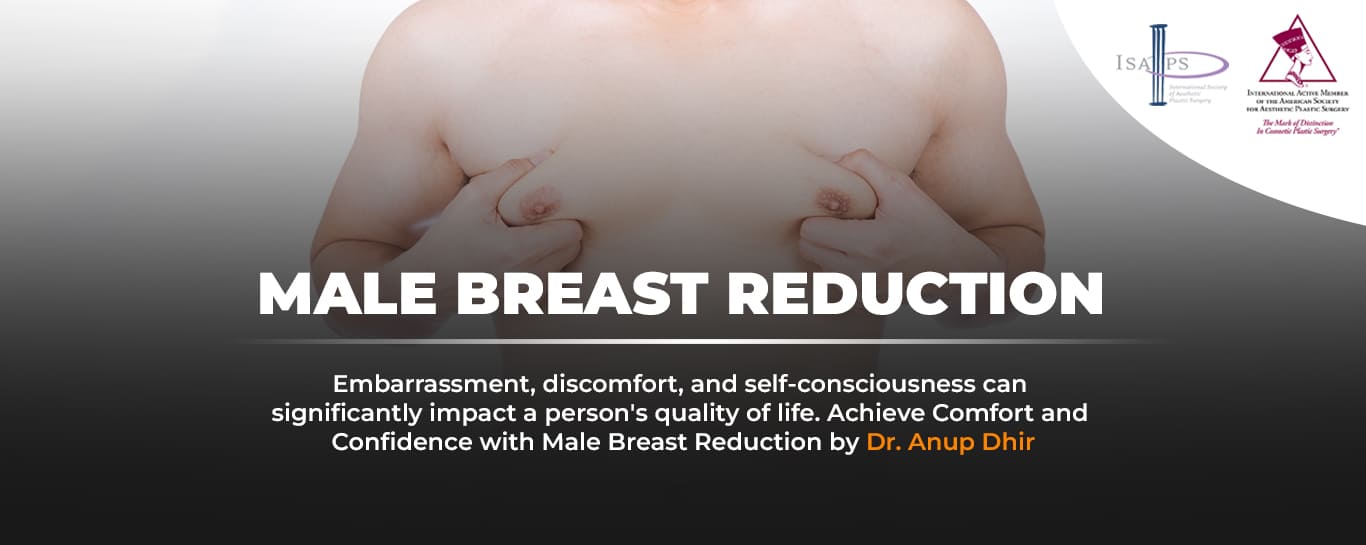
Gynecomastia surgery, commonly pronounced as male breast reduction surgery, is a popular surgical procedure intended to reduce the excess fatty tissue in the male chest area or near the chest area, commonly referred to as "man boobs." This condition is embarrassing and also has a negative impact on a man's self-esteem and confidence.

Gynecomastia is a condition identified by the development of excess breast tissue in men. It can affect men of all ages, from teenagers to older adults. Various factors, including hormonal imbalances, certain medications, obesity, and genetics, can cause male breast problems.
Gynecomastia surgery is typically done under general anesthesia & involves the removal of excess breast fatty tissue and fat from the chest area. The specific technique used will depend on the amount of tissue to be removed and the patient's anatomy. In some cases, liposuction is also used to remove excess fat, while in more severe cases, excision techniques may be necessary. The excess tissue will then be carefully removed. The remaining tissue will be reshaped to create a more masculine chest contour after incisions are closed with sutures accordingly. The garment may be worn to minimize swelling and support the chest during the healing process.
Male breast reduction surgery offers a number of benefits for men struggling with gynecomastia, including:
1. Improved self-confidence: Many men with gynecomastia feel self-conscious about their appearance. Male breast reduction surgery can help restore confidence and improve self-esteem.
2. Enhanced body image: Gynecomastia can make it difficult for men to feel comfortable in their bodies. It helps men achieve a more masculine chest contour and improve their overall body image.
3. Clothing options: Men with gynecomastia may struggle to find clothing that fits properly. It helps men feel more comfortable in their clothing and expand their wardrobe options.
Several different techniques can be used to perform male breast reduction surgery, depending on the individual patient's needs and goals. Some of the most commonly used techniques include:
Liposuction: It is a minimally invasive technique that can be used to remove and reduce the excess fat from the chest area.
Excision: Excision techniques involve the removal of excess breast tissue, fat, and skin through incisions in the chest area. This technique is more invasive than liposuction and may be necessary for patients with severe gynecomastia or significant excess skin.
Combination techniques: In a few cases, both liposuction and excision techniques were used to achieve the best possible results. This approach allows the surgeon to tailor the procedure to the individual patient's needs and goals.
1. Medical Clearance: Your doctor may need to clear you for surgery if you have pre-existing health conditions.
2. Medication Adjustments: Certain medications, like blood thinners, need to be stopped before surgery. Discuss this with your doctor well in advance.Smoking Cessation: Smoking can hinder healing and increase infection risk. Quitting smoking at least 5-6 weeks before surgery is highly recommended.
3. Changes: Discuss any dietary restrictions or supplements you may need to avoid leading up to surgery.
Logistics: Arrange for transportation home after surgery and ensure someone can help you with basic tasks for a few days.
1. Fasting: You will receive specific instructions regarding food and drink restrictions before surgery.
2. Showering: Antiseptic washes might be recommended to reduce infection risk.
3. Clothing: Wear loose-fitting clothing that allows easy dressing post-surgery.
4. Valuables: Leave jewelry and valuables at home.
Recovery following male breast reduction surgery focuses on pain management, swelling reduction, and proper wound healing. Here's what to expect:
1. Rest and Activity: Strict rest is crucial for optimal healing. Avoid strenuous activity as instructed by your surgeon. Short walks are encouraged to improve circulation.
2. Pain Management: Continue pain medication as prescribed. Gradually reduce the dosage as your discomfort eases.
3. Diet: Follow a balanced diet to promote healing. Stay well-hydrated to prevent dehydration.
4. Wound Care: Keep the area clean and follow the surgeon's instructions for dressing changes and wound cleaning.
5. Drainage Tubes: If used, drainage tubes will be removed at a follow-up appointment.
6. Showering: Showers are usually allowed within a few days of surgery. Avoid baths and swimming pools until your surgeon approves.
7. Sleep: Maintain a comfortable sleeping position, often on your back or side, with pillows for support.
8. Follow-up Appointments: Regular follow-up appointments and medical tests are important to monitor healing progress and address any concerns.
After male breast reduction surgery, patients can expect some swelling, bruising, discomfort in the chest area. These few symptoms typically resolve within a few weeks, and most patients are able to return to work and light activities within 1-2 weeks. Physical exercise and heavy lifting should be avoided for at least 5-6 weeks to allow the chest area to heal properly. Most patients are thrilled with the results of their male breast reduction surgery and report feeling more confident and comfortable in their bodies. The outcome of the procedure can take months to fully develop as the swelling & the chest area settle into its new shape. Feeling self-conscious about enlarged breasts? Dr. Anup Dhir, a board-certified plastic surgeon in Delhi with over 38 years of experience, can help. He specializes in male breast reduction surgery & can also provide personalized recommendations based on your needs and goals. He is an expert in male breast reduction surgery and can help you achieve a more masculine chest contour. Book a consultation today to discuss your options and learn how Dr. Dhir can help you feel more confident in your skin.
Male breast reduction, medically known as gynecomastia surgery, is a treatment to remove excess fat in the breast in men. Hormonal imbalances, certain medications, or weight gain can cause this. The surgery can improve physical appearance and alleviate discomfort associated with enlarged breasts.
A consultation with Dr. Anup Dhir, a board-certified plastic surgeon for male chest surgery, is the best way to determine candidacy. They will assess the type and severity of breast tissue enlargement and your overall health and discuss your goals for surgery. During your consultation, the doctor will also explain the surgical techniques, potential risks, and expected outcomes of the procedure. It is important to have realistic expectations and be in good overall health before undergoing male breast reduction surgery.
● Liposuction: It is an invasive technique that can be used to eliminate excess fat from the male chest area. This technique is good for patients with mild to moderate gynecomastia and minimal excess skin. ● Excision: Excision techniques involve the removal of excess breast tissue, fat, and skin through incisions in the chest area. This technique is more invasive than liposuction and may be necessary for patients with severe gynecomastia or significant excess skin. ● Combination method: In some cases, a combination of liposuction and excision techniques can also be used to achieve the best possible results. This approach allows the surgeon to tailor the procedure to the individual patient's needs and goals.
Recovery typically involves wearing a compression garment for several weeks to minimize swelling and support healing. You may experience some discomfort initially, but pain medication can help manage it. Most patients can return to work and light activity within a few days, with a gradual return to strenuous activity over several weeks.
As with all surgeries, there are a few risks, like infection, bleeding, and scarring. It's important to discuss these thoroughly with your surgeon during your consultation.
Hormonal imbalances, certain medications, & medical conditions can all contribute to gynecomastia.
Your surgeon will discuss your medical history in detail to know more, perform a physical exam, and assess your goals and expectations about male breast surgery. They will also explain the surgical techniques, potential risks, & expected outcomes to ensure you have a clear understanding of the procedure. It's important to ask any questions or address any concerns you may have during this consultation.
Scarring is likely, but the extent depends on the technique used.
To learn more about male breast reduction, book an appointment with Dr. Anup Dhir, a board-certified plastic surgeon specializing in male breast reduction. He can provide you with more information and answer any questions you may have about the procedure.

Leave a request to connect to Dr. Anup Dhir for an Appointment.